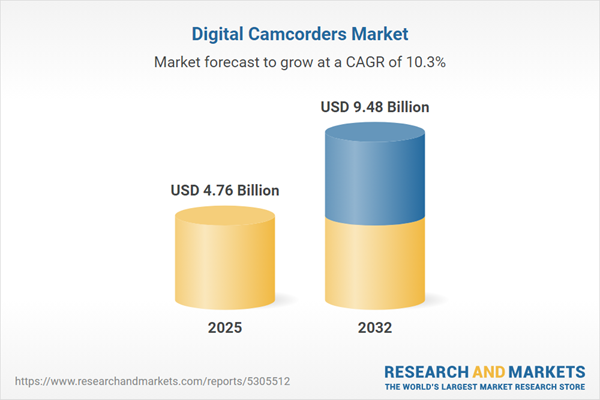Speak directly to the analyst to clarify any post sales queries you may have.
The digital camcorders market is navigating a pivotal transformation, influenced by advances in sensor technologies and connectivity, alongside changing user requirements. Senior leaders in imaging, electronics, and technology sectors must closely monitor these shifts to remain competitive and identify growth opportunities.
Market Snapshot: Digital Camcorders Market Growth and Dynamics
The Digital Camcorders Market grew from USD 4.31 billion in 2024 to USD 4.76 billion in 2025. It is expected to continue growing at a CAGR of 10.32%, reaching USD 9.48 billion by 2032. Growth is propelled by continual innovation in imaging sensors, wireless connectivity, and content integration, positioning the market as a dynamic arena for both established brands and disruptive entrants. Strategic focus on connected hardware, user-centric features, and channel diversification is shaping the future of the digital camcorder market.
Scope & Segmentation
This research report provides thorough analysis across products, technologies, and regional markets to give decision-makers actionable insights. The segmentation covers:
- Distribution Channels: Electronic retailers, hypermarkets and supermarkets, specialty stores, brand websites, and e-commerce platforms.
- Camera Outlook: Bridge cameras, compact digital cameras, integration cameras targeting broad and niche applications.
- Resolution: Full HD, HD, and UHD 4K, supporting a spectrum of end-user performance needs.
- Connectivity Features: Bluetooth, GPS, NFC, and Wi-Fi options enabling seamless file transfer and remote operations.
- End-User Segments: Consumer and professional groups with distinct buying criteria and feature demands.
- Geographical Coverage: Americas (including North and Latin America), Europe, Middle East & Africa, and Asia-Pacific, with country-level granularity across major economies and emerging markets.
- Key Companies Analyzed: Sony Corporation, Canon Inc., Panasonic Corporation, Samsung Electronics Co., Ltd., GoPro, Inc., JVC Kenwood Corporation, and LG Electronics Inc.
Key Takeaways for Senior Decision-Makers
- Technological progress is redefining traditional camcorder applications. Ultra-high-definition imaging, AI-driven processing, and wireless streaming are combining to improve user experience while optimizing professional workflows.
- Distribution channels are experiencing marked divergence. Offline venues like specialty stores remain vital for product demonstrations, while online platforms are driving convenience-based growth and enabling direct-to-consumer engagement.
- A competitive landscape is emerging, with legacy brands leveraging scale and service ecosystems, while agile regional players focus on rapid iteration, localized collaboration, and affordability.
- User segments are more bifurcated. Hobbyists demand compact, easy-to-use devices, whereas professionals require robust performance, modularity, and integrated software workflows.
- Connectivity innovations—including Wi-Fi, Bluetooth, and NFC—are central to product differentiation, enabling remote operation, live sharing, and efficient data management for all market participants.
- Regional adoption is influenced by diverse factors, from mature content creation cultures in the Americas to price sensitivity and infrastructure hurdles in emerging territories. Tailored strategies addressing these market nuances remain essential for unlocking regional growth.
Tariff Impact: Navigating 2025 Supply Chain and Pricing Shifts
The introduction of new tariffs on digital imaging components and finished goods in 2025 has caused significant disruptions. Manufacturers face increased unit costs, prompting shifts toward alternative suppliers or domestic assembly to manage exposure. Wholesale and retail pricing structures are adapting as some market participants absorb costs and others adjust markups, resulting in a varied pricing environment. The industry’s resilience will depend on flexible supply chains and proactive regional diversification.
Methodology & Data Sources
This report is grounded in a multi-source research approach, combining interviews with value chain stakeholders and corroboration from industry publications, regulatory documents, and technology reports. Expert validation and rigorous cross-checks ensure insights are accurate and reflect current market complexities.
Why This Report Matters
- Equips decision-makers with an in-depth understanding of market forces shaping technology adoption and competitive dynamics.
- Supports strategic planning through accurate segmentation, actionable growth projections, and risk mitigation recommendations.
- Enables alignment of product development, supply chain management, and channel strategies with evolving tariff and regulatory landscapes.
Conclusion
The digital camcorders market is experiencing a period of creative, competitive, and structural change. By leveraging actionable insights, stakeholders can position themselves for sustained opportunity amid evolving technologies and regulatory conditions.
Additional Product Information:
- Purchase of this report includes 1 year online access with quarterly updates.
- This report can be updated on request. Please contact our Customer Experience team using the Ask a Question widget on our website.
Table of Contents
3. Executive Summary
4. Market Overview
7. Cumulative Impact of Artificial Intelligence 2025
Companies Mentioned
The companies profiled in this Digital Camcorders market report include:- Sony Corporation
- Canon Inc.
- Panasonic Corporation
- Samsung Electronics Co., Ltd.
- GoPro, Inc.
- JVC Kenwood Corporation
- LG Electronics Inc.
Table Information
| Report Attribute | Details |
|---|---|
| No. of Pages | 184 |
| Published | October 2025 |
| Forecast Period | 2025 - 2032 |
| Estimated Market Value ( USD | $ 4.76 Billion |
| Forecasted Market Value ( USD | $ 9.48 Billion |
| Compound Annual Growth Rate | 10.3% |
| Regions Covered | Global |
| No. of Companies Mentioned | 8 |









